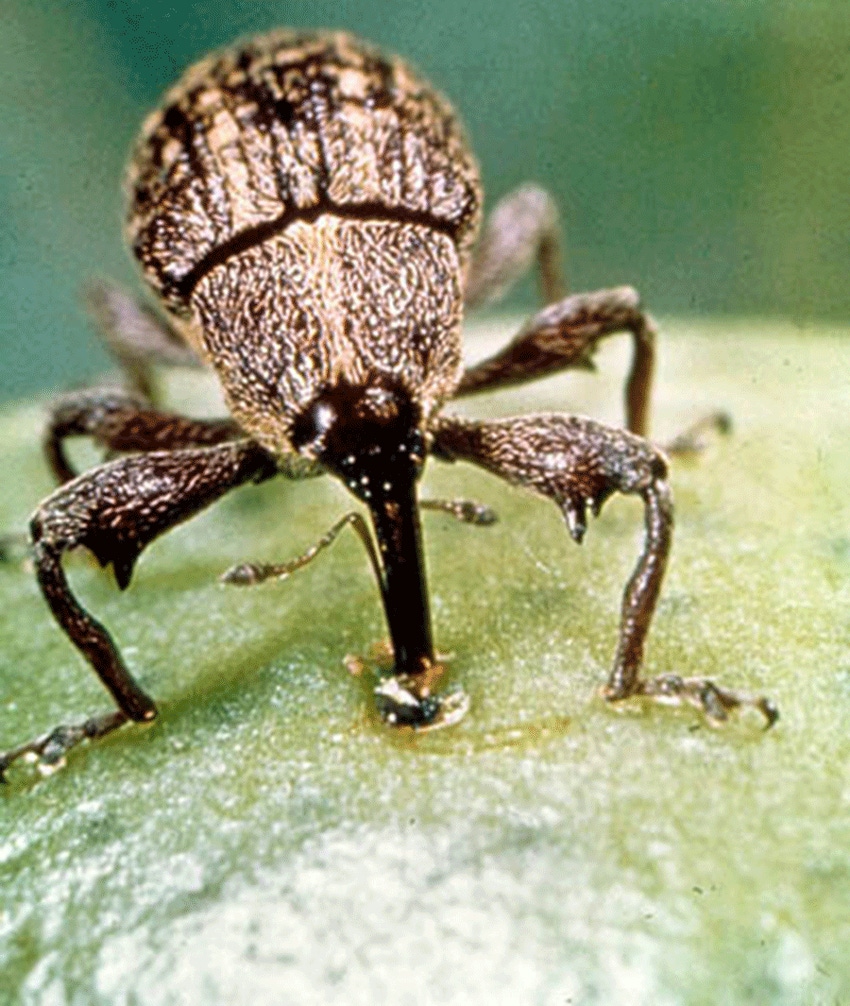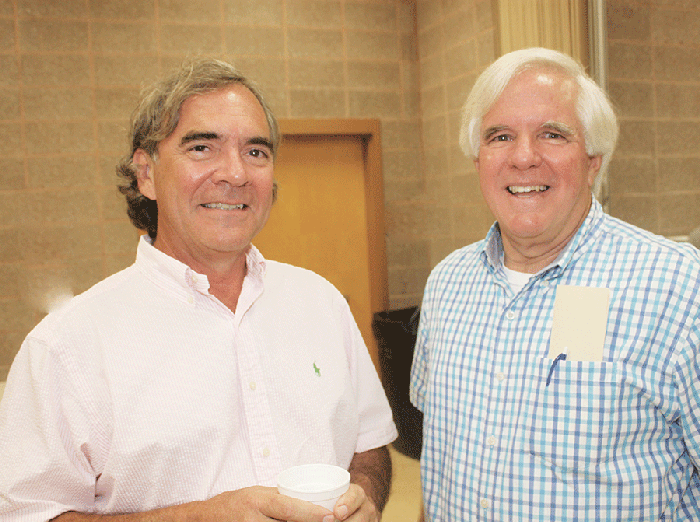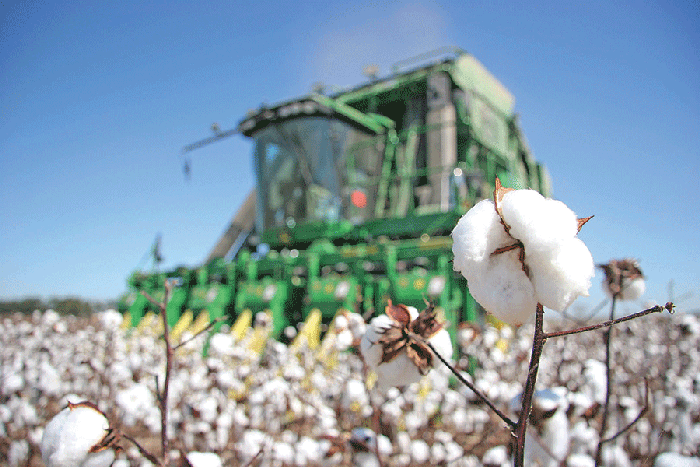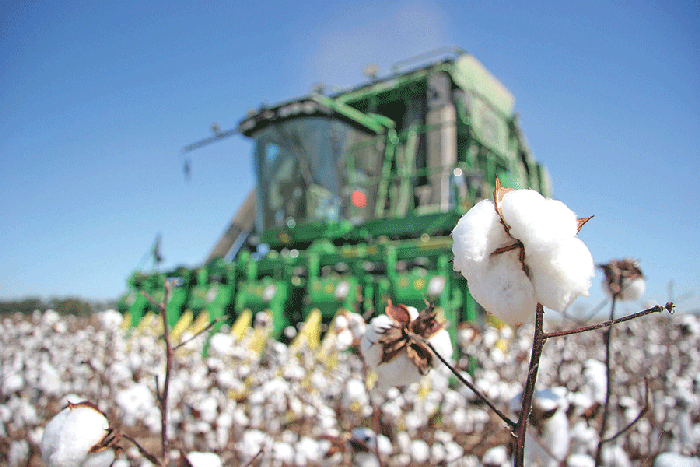
As he had done for the past nine years, Farrell Boyd was beaming at the joint annual meeting of the Mississippi Boll Weevil Management Corporation and the Mississippi Farm Bureau Federation Cotton Policy Committee.
“It’s a pleasure for me to echo what I’ve said for the last nine years: Mississippi continues to be boll weevil-free,” said Boyd, who is program manager for the organization. “We’re going into our 10th year and not the first weevil has been caught — which is great! And we’ve gone from over 500 employees during the height of the eradication effort to just five today.��”

Robert Royal, left, Midnight, Miss., producer/ginner, and James Langley, V&M Cotton Brokers, Yazoo City, Miss., were among those attending the joint annual meeting of the Mississippi Boll Weevil Management Corporation and the Mississippi Farm Bureau Federation Cotton Policy Committee.
Mississippi producers, and others throughout most of the nation’s cotton-producing regions, have saved many millions of dollars by no longer having to battle the pest that had destroyed cotton yields for decades, he says.
Still, “We’re not letting our guard down — we’re continuing to operate the Mississippi program in a surveillance mode. We have pheromone traps within a mile of every cotton field in the state, and we monitor them throughout the season in case any weevils should slip in on farm equipment coming from the south Texas areas where the eradication effort is still under way.”
SOUTH TEXAS AND MEXICO AREAS REMAIN
Nearly all of the U.S. cotton belt is now weevil-free, Boyd notes. “The only place where weevils still exist is in the Rio Grande Valley bordering Mexico, along the Rio Grande River, and south of Uvalde in the Winter Garden area, which is a reinfestation area. The reinfestation there emphsizes why we have to be so careful — it’s not impossible weevils could reoccur here as a result of being transported in from an infested area. It’s very important that we continue our surveillance program.”
The cooperative program between Mexico, the Texas Boll Weevil Foundation, and APHIS, to provide training and equipment for Mexico has been “very effective” in enhancing the eradication effort in that region, he says. “Unfortunately, they continue to have intermittent problems with drug cartels. A recent report noted that Mexican eradication workers were out of the field several times due to gun battles in the area. That kind of environment makes their eradication effort even more challenging.”

Nearly all of the U.S. cotton belt is now boll weevil-free. Only areas in southernmost Texas and across the Rio Grande River in Mexico remain to be eradicated.
But, Boyd says, there has been “significant progress” on both sides of the border. “Through June 12, in the Rio Grande Valley of Texas, they had an 81.4 percent decrease in weevil captures compared to a year ago. In the Mexican program across the river, through June 12 they’d captured 539 weevils, a 91 percent decrease over 2016.��”
Both areas have significant increases in cotton acreages this year, he says, which could have an impact on weevil numbers, “but we’re still comfortable that they’re going to achieve eradication. The cooperative effort with Mexico has been a major achievement.”
BUFFER ZONE TO PREVENT REINFESTATION
Starting in 2014, he notes, the National Cotton Council Boll Weevil Action Committee established a buffer zone in the lower Rio Grande Valley to hopefully protect the rest of the cotton belt from weevil intrusion.
“An assessment was levied to fund the buffer zone, and in 2014 each state contributed 50 cents per acre, with 25 cents per acre in years since then. The buffer program will be reevaluated at the end of five years. So far, none of the money collected has been spent because the buffer zone is in the area where the Texas boll weevil eradication is going on, so it hasn’t cost any additional money to maintain the buffer. By the end of this year the fund will have accumulated between $11 million and $12 million, which is about enough to operate the program. So, they’re holding the money in escrow in the event some of it is needed for that.”
Everything is still “looking very promising” for eradication in the lower Rio Grande Valley, Boyd says, “and we’re looking forward to another weevil-free season in Mississippi. We appreciate everyone’s assistance in watching for harvest equipment or other equipment coming into our state from south Texas so we can be sure no weevils sneak in.
Coley Bailey, Jr., Grenada, Miss., producer, and president of the Mississippi Boll Weevil Management Corporation, echoed Boyd’s enthusiasm for the ongoing success of the program: “It’s great to be almost 10 years weevil-free. When I attended my first board meeting we were $60 million in debt; today we’re blessed to be in strong financial condition. But reinfestation could be costly — and we want to do all we can to prevent that from happening.”
About the Author(s)
You May Also Like




